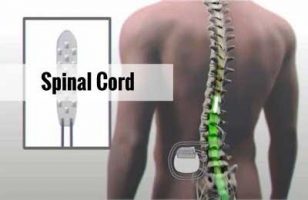- Home
- Editorial
- News
- Practice Guidelines
- Anesthesiology Guidelines
- Cancer Guidelines
- Cardiac Sciences Guidelines
- Critical Care Guidelines
- Dentistry Guidelines
- Dermatology Guidelines
- Diabetes and Endo Guidelines
- Diagnostics Guidelines
- ENT Guidelines
- Featured Practice Guidelines
- Gastroenterology Guidelines
- Geriatrics Guidelines
- Medicine Guidelines
- Nephrology Guidelines
- Neurosciences Guidelines
- Obs and Gynae Guidelines
- Ophthalmology Guidelines
- Orthopaedics Guidelines
- Paediatrics Guidelines
- Psychiatry Guidelines
- Pulmonology Guidelines
- Radiology Guidelines
- Surgery Guidelines
- Urology Guidelines
Man moves paralyzed legs using device that stimulates spinal cord

Mayo Clinic researchers used electrical stimulation on the spinal cord and intense physical therapy to help a man intentionally move his paralyzed legs, stand and make step like motions for the first time in three years.
The case, the result of collaboration with UCLA researchers, appears in Mayo Clinic Proceedings. Researchers say these results offer further evidence that a combination of this technology and rehabilitation may help patients with spinal cord injuries regain control over previously paralyzed movements, such as step like actions, balance control and standing.
"We're really excited, because our results went beyond our expectations," says neurosurgeon Kendall Lee, M.D., Ph.D., principal investigator and director of Mayo Clinic's Neural Engineering Laboratory. "These are initial findings, but the patient is continuing to make progress."
The 26-year-old patient injured his spinal cord at the sixth thoracic vertebrae in the middle of his back three years earlier. He was diagnosed with a motor complete spinal cord injury, meaning he could not move or feel anything below the middle of his torso.
The study started with the patient going through 22 weeks of physical therapy. He had three training sessions a week to prepare his muscles for attempting tasks during spinal cord stimulation. He was tested for changes regularly. Some results led researchers to characterize his injury further as discomplete, suggesting dormant connections across his injury may remain.
Following physical therapy, he underwent surgery to implant an electrode in the epidural space near the spinal cord below the injured area. The electrode is connected to a computer controlled device under the skin in the patient's abdomen. This device, for which Mayo Clinic received permission from the U.S. Food and Drug Administration for off-label use, sends electrical current to the spinal cord, enabling the patient to create movement.
After a three-week recovery period from surgery, the patient resumed physical therapy with stimulation settings adjusted to enable movements. In the first two weeks, he intentionally was able to:
- Control his muscles while lying on his side, resulting in leg movements
- Make steplike motions while lying on his side and standing with partial support
- Stand independently using his arms on support bars for balance Intentional, or volitional, movement means the patient's brain is sending a signal to motor neurons in his spinal cord to move his legs purposefully.
"This has really set the tone for our post-surgical rehabilitation trying to use that function the patient recovered to drive even more return of abilities," says Kristin Zhao, Ph.D., co-principal investigator and director of Mayo Clinic's Assistive and Restorative Technology Laboratory.
The Mayo researchers worked closely with the team of V. Reggie Edgerton, Ph.D., at UCLA on this study, which replicates earlier research done at the University of Louisville. The Mayo study marks the first time a patient intentionally controlled previously paralyzed functions within the first two weeks of stimulation.
The data suggest that people with discomplete spinal cord injuries may be candidates for epidural stimulation therapy. However, more research is needed into how a discomplete injury contributes to recovering function.
Teams from Mayo Clinic's departments of Neurosurgery and Physical Medicine and Rehabilitation, and the Division of Engineering collaborated on this project.
"While these are early results, it speaks to how Mayo Clinic researchers relentlessly pursue discoveries and innovative solutions that address the unmet needs of patients," says Gregory Gores, M.D., executive dean of research, Mayo Clinic. "These teams highlight Mayo Clinic's unique culture of collaboration, which brings together scientists and physician experts who work side by side to accelerate scientific discoveries into critical advances for patient care."
You can read the full Article by clicking on the link :
Peter J. Grahn, Igor A. Lavrov, Dimitry G. Sayenko, Meegan G. Van Straaten, Megan L. Gill, Jeffrey A. Strommen, Jonathan S. Calvert, Dina I. Drubach, Lisa A. Beck, Margaux B. Linde, Andrew R. Thoreson, Cesar Lopez, Aldo A. Mendez, Parag N. Gad, Yury P. Gerasimenko, V. Reggie Edgerton, Kristin D. Zhao, Kendall H. Lee. Enabling Task-Specific Volitional Motor Functions via Spinal Cord Neuromodulation in a Human With Paraplegia. Mayo Clinic Proceedings, 2017; 92 (4): 544 DOI: 10.1016/j.mayocp.2017.02.014

Disclaimer: This site is primarily intended for healthcare professionals. Any content/information on this website does not replace the advice of medical and/or health professionals and should not be construed as medical/diagnostic advice/endorsement or prescription. Use of this site is subject to our terms of use, privacy policy, advertisement policy. © 2020 Minerva Medical Treatment Pvt Ltd